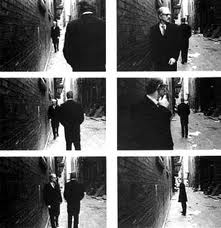Michals began his artwork at the age of 14, whilst attending Watercolour University Classes at the Carnegie Institute, also known as Carnegie Museum of Art, located in Pittsburgh.
He received a B.A. from the University of Denver in 1953. He went into the Army for two years, when after, in 1956, he went on to study at the Parsons School of Design, with his plan to becoming a graphic designer, however he didn't succeed, and did not complete his studies.
Michals describes his photographic skills as "Completely self-taught." During a holiday in the USSR, in 1958, he discovered an interest in photography. The photographs he made during this trip became his first exhibition held in 1963 at The Underground Gallery in New York.
Duane Michals was a commercial photographer for several years, he worked for Esquire and Mademoiselle. He also covered the filming of The Great Gatsby for Vogue in 1974. He did not have a studio to work in, he took portraits of people in their environment instead, which was a contrast to the method of other photographers at the time, such as Avedon and Irving Penn.
The Government of Mexico hired Michals in 1968 to photograph the Olympics. His work was shown at The Museum of Modern Art in New York in 1970. The portraits he took between 1958 and 1988 later became the basis of his book, Album.
In 1976, Michals received a grant from the National Endowment for the Arts. Michals also produced the art for the album Synchronicity, by the Police, in 1983, and also the album Clouds Over Eden by Richard Barone, in 1993.
Some of Michals' photography has addressed gay themes, although he has not been involved in gay civil rights. Michals influences for his work are Balthus, William Blake, Lewis Carroll, Thomas Eakins, Rene Magritte, and Walt Whitman. He has also been an influence to others too, such as David Levinthal and Francesca Woodman.
He is noted for two innovations in artistic photography developed in the 1960s and 1970s. Firstly he told a story through a series of his photos, as in his book, Sequences, in 1970. Secondly, he hand wrote text near his photographs, thereby giving information that the image itself could not convey.
Duane Michals has received two awards, which are; A gold medal for photography at the National Arts Club, in 1994, and also the Masters Series Award, at the School of Visual Arts, in 2000.
Michals' work is a comparison to the first piece of work I did, which is a sequence of movement. I used several images, just like Michals did, and placed them all on the same page, so that you could see the different times of the movement.







No comments:
Post a Comment